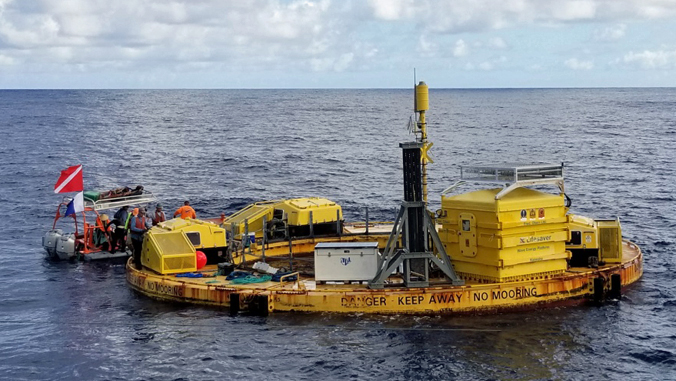
Naval Facilities Engineering and Expeditionary Warfare Center (NAVFAC EXWC) in partnership with the University of Hawaiʻi launched its second round of Wave Energy Converter (WEC) testing at the U.S. Navy’s Wave Energy Test Site off Marine Corps Base Hawaiʻi on Oʻahu.
This is the world’s first demonstration of the potentially transformative capability for WECs to enable persistent oceanographic observation and unmanned, undersea vehicle recharge without a cable to shore.
In October 2018, the Applied Research Laboratory at the University of Hawaiʻi, with funding from NAVFAC and in partnership with the University of Washington, Fred. Olsen Ltd. and Sea Engineering Inc. began the second round of testing of the “BOLT Lifesaver” WEC device.
The device uses three power take-off units that convert the motion of the passing waves to electrical power using rotary electrical generators. Control and health-monitoring of these on-board systems are housed in the control center. The WEC is not connected to shore, and the power generated is stored in a battery bank.
This phase of Lifesaver testing has two primary aims—to improve device reliability and power performance, through alterations to the device mooring strategy, and to demonstrate an alternative means of powering oceanographic instrumentation without using utility-supplied electrical grid power or single-use batteries.
The instrumentation, known as the Wave-powered Adaptable Monitoring Package (WAMP), is being tested on the BOLT Lifesaver. Receiving its power from the Lifesaver, the WAMP provides persistent underwater sensing and supports unmanned, undersea vehicle recharge using a wireless power transfer system.
The WAMP is the latest in a series of demonstrations and is used in this application to better understand the marine environment around an operational WEC buoy.
The joint Lifesaver-WAMP test is funded by NAVFAC, the U.S. Department of Energy and the National Science Foundation. The overall effort is part of a larger joint U.S. Navy, Department of Energy, academic (University of Hawaiʻi, Hawaiʻi Natural Energy Institute and University of Washington) and industry research, development, test and evaluation project.

